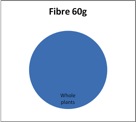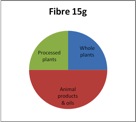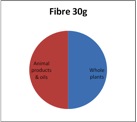It would seem from the billions of dollars spent annually on vitamin supplements that Australians recognise the importance of nutrients. The essential nutrients include eight amino acids, two types of fats, minerals and the vitamins (organic molecules that the body cannot synthesise). These are known as essential nutrients because the absence of any one of these will cause deficiency symptoms and eventually death. Plant foods provide all of the essential nutrients. But plants also contain other “phytonutrients” (phytochemicals). These include dietary fibre, anti-oxidants, cancer fighting chemicals and other biologically active substances perhaps numbering 100,000 in total. These non-essential nutrients are “essential” for good health and longevity. Meats, eggs and dairy foods lack these phytonutrients, or at best contain only trace amounts.
Nutrient density is an important consideration in making healthy food choices. A good question to ask yourself when choosing foods is “does it contain dietary fibre and nutrients”? If the answer is no then perhaps that item should not be a significant part of your diet. Other factors such as energy density and fat content are also relevant. We consider that there is more evidence to support a high carbohydrate diet based on starchy foods such as grains, legumes and potatoes than a diet based on oily plants such as nuts, seeds and avocados.
What is nutrient density? Put simply it’s how concentrated the vitamins, minerals and phytonutrients are in your diet. Nutrient density can be expressed as nutrient units per gram of food, but then high energy density foods, such as nuts and oils, would appear high in nutrients but you could not eat as much off them as say broccoli or spinach because you would get too many calories. So we express nutrient density in nutrient units per calorie of that food. (This too can sometimes be misleading because some vegetables have so few calories that you simply could not fit enough calories worth on your plate to obtain the nutrients in, say 500 calories). It gets increasingly complicated as we delve deeper. A particular plant food might be high in some nutrients and lower in others which is why we recommend eating a wide variety of plant foods rather trying to find one “super food” that has everything.
The nutrient density of your total diet is not just influenced by your high nutrient choices but also by your low nutrient choices. High calorie, low nutrient foods reduce your total nutrient intake. This is because they use up your total day’s calorie needs, and you therefore eat less of the other more nutrient dense foods. For example, spreading margarine on a piece of bread adds about an extra third to the calorie count of that slice: it now contains 4/3 of the original calories. But the ¼ of the calories that comes from the margarine contributes almost no nutrients, so the buttered bread still only contains the nutrients of the plain bread. Therefore the nutrient density has been reduced to ¾ of what you would get from eating all of those calories from bread. You have effectively lost ¼ of the iron, protein, thiamine, dietary fibre and other nutrients. The same happens when we use oil in cooking, or eat a lot of sugar, such as from soft drinks. “But”, you protest, “I am going to eat just as much bread, whether or not it has margarine on it”. Let us explain this fallacy in more detail.
You have a daily calorie budget to divide up among different foods. How you spend it is your choice. How many calories you have to spend each day is pre-determined by your metabolism. You have limited control over this. You can exercise more and your budget will be a little bigger but you still have to eat within your calorie budget. Why do you have to? If you habitually exceed your daily calorie budget then your body will be forced to store the over budget calories as fat, and you will gain weight. Most people understand this, but do not fully appreciate the implications of the calorie budget in respect to nutrients.
Many health conscious Australians believe that they eat a high fibre diet, and our nutritional authorities tell us that we can get plenty of dietary fibre by eating some whole grains and vegetables along with meat, dairy, and good oils. You may think, sure I eat chicken, eggs, dairy foods, good oils and processed grains in moderation but I also eat high fibre breakfast cereal, and some vegetables and fruit: I eat a high fibre diet. The following pie charts illustrate how fibre intake decreases as you use up your daily calorie budget on foods that contribute no dietary fibre. Note that they are for concept only and do not imply exact proportions.
Fraction of food calories that contributes dietary fibre (blue):



Dietary fibre is just one example how your daily calorie budget limits your nutrient intake. The same general principle applies to all of the other vitamins, minerals and phytonutrients that we obtain from whole plant foods. For example, toddlers are at risk of iron deficiency if they consume a lot of dairy products because cow’s milk uses up their daily calorie allowance but provides negligible iron. The phytonutrients, as the name would suggest, are specific to plants. If you eat more animal products and highly processed foods such as vegetable oils then you leave a smaller segment of pie to provide your phytonutrients.
Here is an idea for a food labelling system that communicates how low nutrient density foods reduce your daily nutrient intake. Perhaps special food labels could be designed for high energy no nutrient foods such as vegetable oils and sugary drinks. Vitamins and mineral values will be written as negative numbers to reflect the extent to which these foods reduce the overall nutrient content of the diet. (The minus numbers in the label below represent the nutrients that would have been obtained from the same number of calories/kilojoules of, for example, wholemeal bread):
OLIVE OIL
NUTRITION INFORMATION
SERVINGS PER PACKAGE: 50
SERVING SIZE: 15mL
QTY PER QTY PER
SERVING 100mL
Energy 510kj 3400kj
Fat total 13.8g 92g
Protein – 4.6g – 31g
Calcium – 48mg – 318mg
Iron – 1mg – 7.2mg
Fibre – 3.3g – 22g
Our culture is big on quick fixes to our problems and nutrition is no exception. Might there be some super food that we can add to an otherwise low nutrient density diet to fix it? There are indeed many plant foods that are very high in particular nutrients and antioxidants. But there are no “super foods” that will cancel out the negative effects of excess animal proteins and processed foods and no foods that provide a stand-alone diet (other than the milk of an infant’s mother and even this will be dependent on the mother’s food intake). The list below is a random selection of foods high in particular vitamins, minerals or phytochemicals. We use such knowledge to tweek our diets, for example increasing our omega-3 consumption by adding flaxseed meal to porridge, and including generous amounts of green leafy vegetables and cruciferous vegetables in our evening meal.
Food High in Particular Phytonutrients:
- Flaxseed and Chia seeds – omega 3 essential fatty acids
- Kale and other green leafy vegetables are rich in many nutrients and anticancer substances. Enhance artery function
- Yellow and orange vegetables are high in carotenoids and have anticancer effects.
- Berries are high in nutrients and anti-oxidants
- Tomatoes contain the anticancer substance lycopene
- Onions and garlic contain anticancer substances and enhances iron absorption
- Soy products contain phytoestrogens which reduce the risk of oestrogen related cancers such as prostate and breast cancers
- Whole grains are rich in nutrients and dietary fibre
- Potatoes come close to containing enough of every nutrient
Recommendation: make everything you eat count towards your nutrient intake.
See also: Energy Density ; Energy Pie ;
Resources
- Paddison Program – Nutritionally Complete In The Baseline Phase – 37 min video interview between Clint Paddison and nutritionist Robyn Chuter showing how easy it is to meet nutritional needs eating a simple diet of quinoa, buckwheat, sweet potato and greens, adding a little seaweed and garlic to meet those nutrients known to be low in Australia – iodine and selenium.
- A Simple Nutritious & Affordable Plan (SNAP) – Jeff Novick shows how easily you can meet nutrient RDI’s with a simple starch based diet
- This short video explains the benefits of getting phytonutrients from a variety of plants: Apples and Oranges: Dietary Diversity
- And this video addresses the subject of quality vs quantity of vegetables. Even when choosing the same quantity of fruits and vegetables, those making higher antioxidant choices experienced a reduction in C-reactive protein (inflammation) levels: Anti-Inflammatory Antioxidants
- Eggs are promoted as a source of eye protecting anti-oxidants. Watch this video to see the absurdity of this claim… Egg Industry Blind Spot
Food composition tables:
- Australian Food Composition Database – previously called NUTTAB, this is a reference database that contains data on the nutrient content of Australian foods
- USDA Food Data Central – User-friendly access to USA food composition data
- NutritionData.com – USA. Includes percentage energy from carbohydrates, proteins, fats
